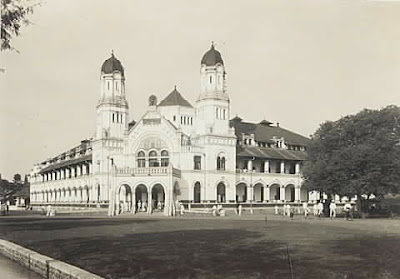Lawang Sewu will no longer be a haunted, sad place

Recently, the daily newspaper "The Jakarta Post" published an article "Lawang Sewu, a haunted, sad place." Now, after years of neglect and uncertainty, the former Nederlandsch-Indische Spoorweg Maatschappij (Netherlands Indies Railway Company, or NIS) head office is being restored by the Indonesian Railway Company (PTKA) Regional Office in Semarang. When this building was completed in 1907 it was a very modern building. The architects, J.F. Klinkhamer and B.J. Ouëndag, made a careful study of Semarang’s climatic condition. As a result, they came up with a design which is dominated by galleries (inspired by the front and rear galleries [voor- en achter galerijen] of Indies style houses) and louvered doors (in fact, many of them).

This is why the people of Semarang affectionately gave the building the nickname “Lawang Sewu” (“The Thousand Doors” in Javanese). Recently, however, the building is more known as a haunted place. This, no doubt, recalls the time when it was used as a place of interrogation by the infamous Kempetai, and when Lawang Sewu was witness to the fierce battle in October 1945 between Semarang’s youth and the defeated Japanese forces. Now, tours are conducted to visit the building’s basement where tiny, half submerged cells were used in those days to torture prisoners. The guides of this tour will tell colourful ghost tales.
After Indonesia’s independence Lawang Sewu was taken over by the Army, and used as one of its headquarters. But in the early 1990s it was returned to PTKA. It served briefly as the office of the provincial Transportation Department, but then was virtually abandoned. Various plans, among them to turn it into a de luxe hotel, appeared and disappeared but nothing really happened. Finally, the City of Semarang threatened to take over the building. In their view, in its dilapidated state it had started to become an eyesore as it commands a very prominent place in the city. It faces one of Semarang’s main squares and is located just across the governor’s mansion.

In a not too subtle power game, PTKA responded by quietly placing a steam engine, C2301, a 0-6-0 1907 Hartmann tank engine that used to be stored (derelict) at the Ambarawa Railway Museum, right in front of Lawang Sewu. C2301 was originally the Netherlands Indies Railway Company's NIS263.
 C2301 at Ambarawa (Photo: Nick Bryant)
C2301 at Ambarawa (Photo: Nick Bryant)
 C2301 at Ambarawa (Photo: Nick Bryant)
C2301 at Ambarawa (Photo: Nick Bryant)Now, work is still going on to renovate the building. It is planned that the PTKA Semarang Regional Office will move into the building in May 2009. It will occupy most of the upper level, while the ground floor will be used for a ticket reservation office and some upscale shops and restaurants. The Indonesia Railway Preservation Society (IRPS) has also been offered a place in the building, on the condition that it will open a small exhibition and library dedicated to the history on Indonesian railways which the general public can access.
 The famous stained glass windows
The famous stained glass windows


Comments